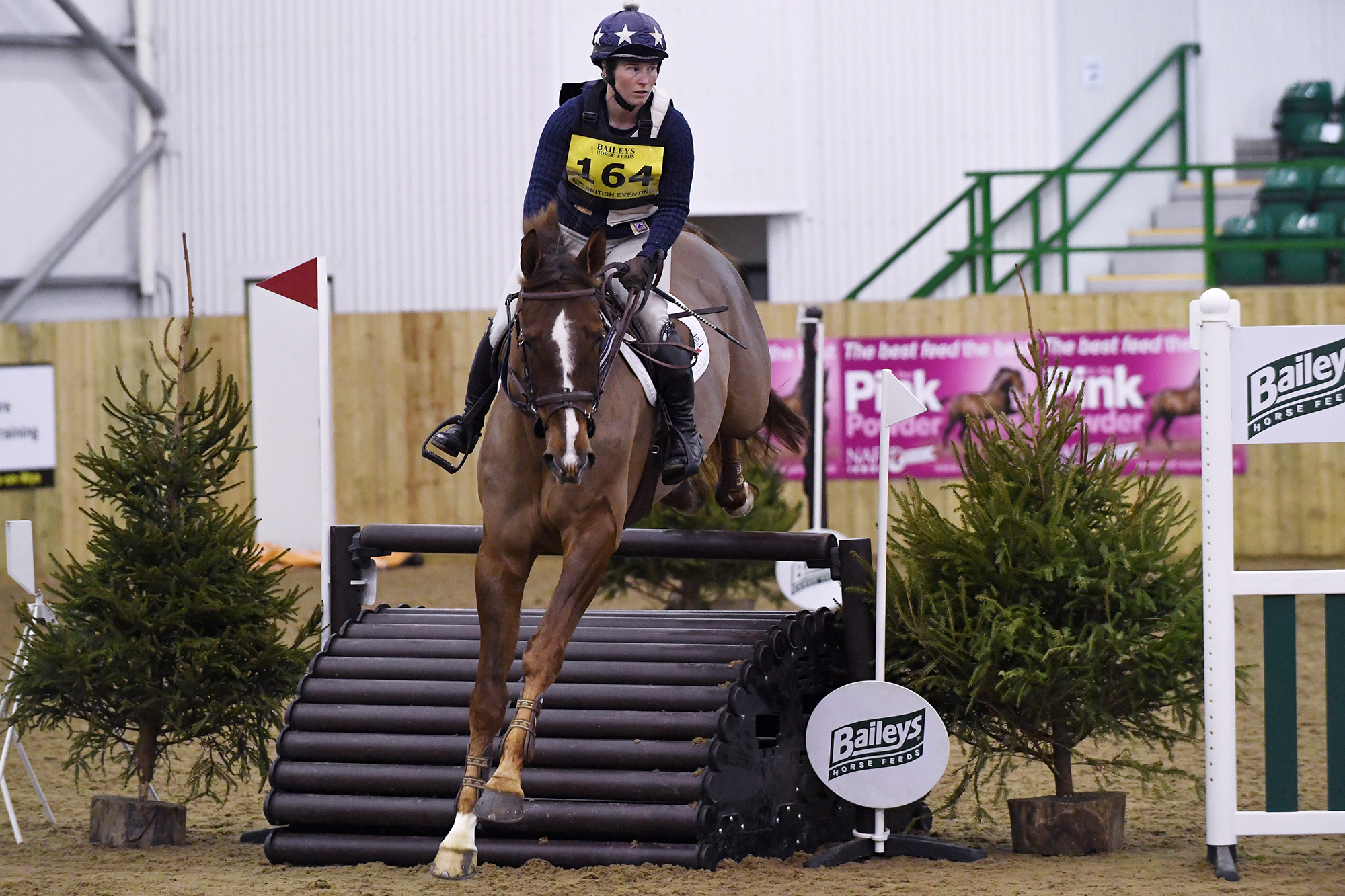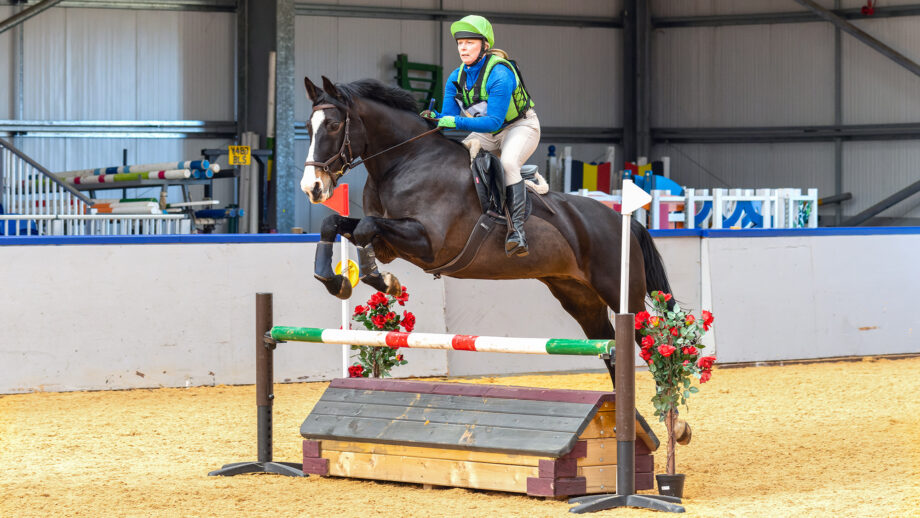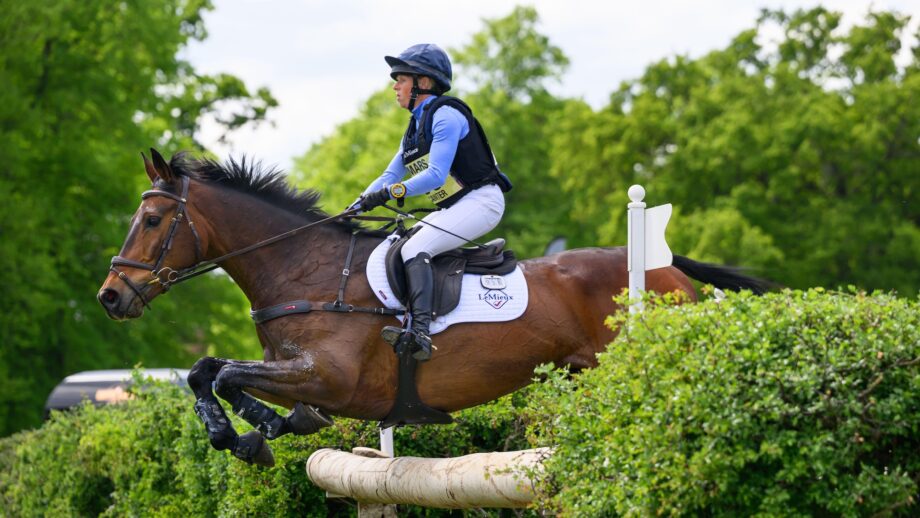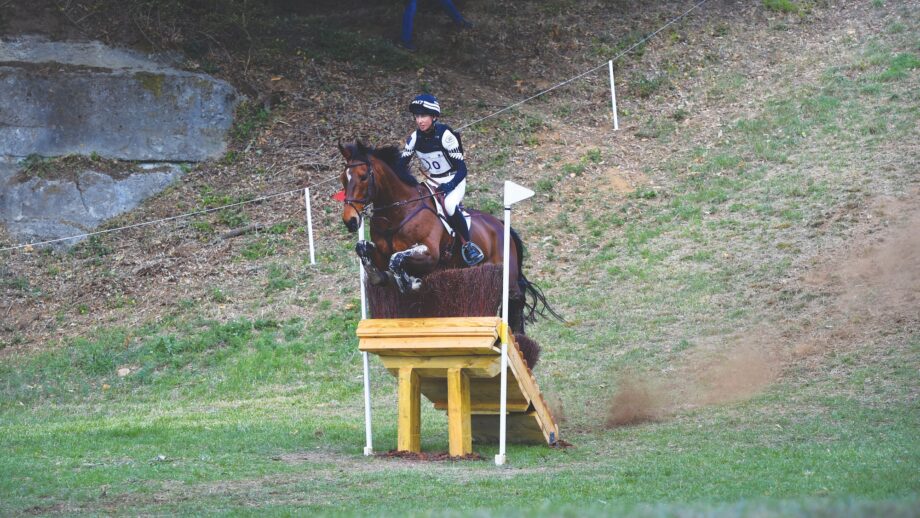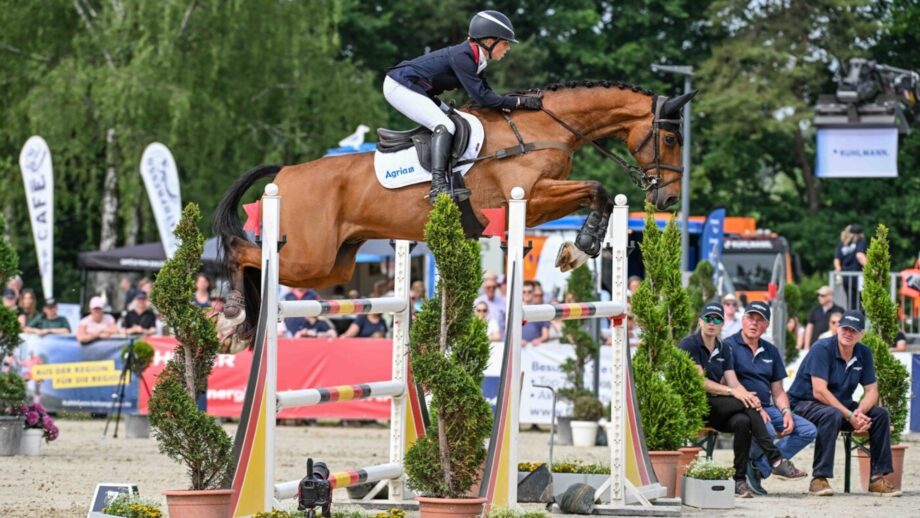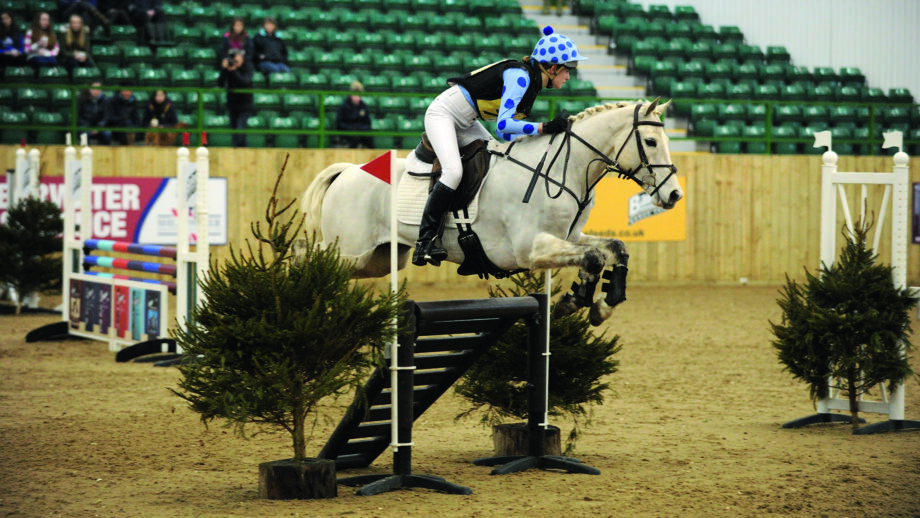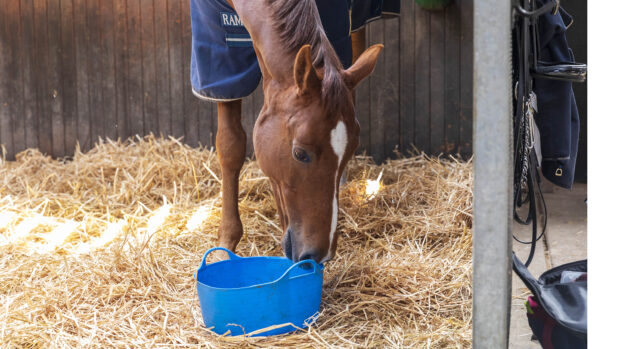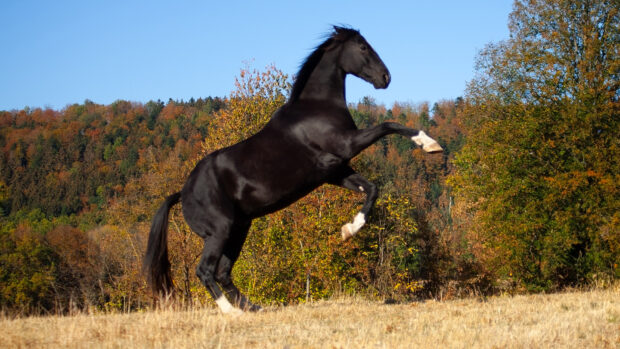Horse & Hound is supported by its audience. When you purchase through links on our site, we may earn commission on some of the items you choose to buy.
Learn more
In this exclusive article for H&H subscribers, five-star event rider and Fellow of the British Horse Society Kylie Roddy shares her tips on how to prepare for arena eventing competitions, as well as advice on how to be successful in competitions
Arena eventing can be a great way to sharpen your skills over the winter – but perhaps you’re looking for some tips? You may need to do some training first and are not sure what to focus on? Or do you want to improve on your performance from last season with a view to being more competitive?
We asked renowned trainer Kylie Roddy for her top tips for arena eventing. Kylie won at the championships of British Eventing’s previous arena eventing series , Jumping And Style (JAS), and judges arena eventing competitions.
“There is something for everybody with those classes – it’s all about what your expectations are and whether you’re looking for ‘ride skills’ or ‘competitive skills’,” says Kylie. “For some it’s about educating a young horse, others are going to train and school and then there are those looking to be competitive.”
Kylie Roddy taking part in an arena eventing competition. Credit: Peter Nixon
Kylie’s arena eventing tips
Whatever your aim, Kylie says there are two main areas she focuses on for everyone in arena eventing training.
{"content":"PC9wPgo8aDM+S2VlcGluZyBhIHF1YWxpdHkgY2FudGVyPC9oMz4KPHA+4oCcVHlwaWNhbGx5IGFyZW5hIGV2ZW50aW5nIGNvdXJzZXMgYXJlIGxvbmdlciB0aGFuIHlvdXIgYXZlcmFnZSBzaG93anVtcGluZyBjb3Vyc2Ug4oCTIHRoZXJlIG1pZ2h0IGJlIDIwIG9yIDI0IGZlbmNlcywgc28gdHdpY2UgYXMgbWFueSBhcyBvbiBhIHNob3dqdW1waW5nIHRyYWNrLOKAnSBwb2ludHMgb3V0IEt5bGllLiDigJxTbyBiZWluZyBhYmxlIHRvIGtlZXAgdGhlIGNhbnRlciBhbmQgdGhlIGFkanVzdGFiaWxpdHkgYW5kIHF1YWxpdHkgaW4gdGhlIGNhbnRlciBpcyBpbXBvcnRhbnQsIGZyb20gNzBjbSBhbGwgdGhlIHdheSB1cCB0byBwcmVzdGlnaW91cyBpbmRvb3IgY29tcGV0aXRpb25zIGZvciB0b3AgcmlkZXJzIGxpa2UgU3R1dHRnYXJ0LCBhbmQgdGhlcmXigJlzIGEgZml0bmVzcyBlbGVtZW50IHRvIHRoYXQuPC9wPgo8cD7igJxUaGUgc3BlZWQgcmVxdWlyZWQgaXMgZmFzdGVyIHRoYW4gYSB0eXBpY2FsIHNob3dqdW1waW5nIHJvdW5kIGF0IHRoZSBsZXZlbCwgYnV0IGl04oCZcyBhbHNvIG5vdCBsaWtlIHlvdSBjYW4ganVzdCBzZXR0bGUgaW50byBhIGdhbGxvcCDigJMgdGhlIGNvdXJzZXMgaGF2ZSBhIGp1bXAtb2ZmIHR5cGUgZmVlbCB3aXRoIHR1cm5zIGFuZCBjaGFuZ2VzIG9mIHBhY2UgbmVlZGVkLCBzbyB0aGUgaG9yc2VzIGhhdmUgdG8gYmUgZmFzdCBpbiB0aGVpciBtaW5kIGFuZCB5b3UgaGF2ZSB0byBiZSBhYmxlIHRvIHJpZGUgaW4gYmFsYW5jZSBhdCBhIGhpZ2hlciBzcGVlZC7igJ08L3A+Cgo8cD5LeWxpZSBzdWdnZXN0cyByaWRlcnMgcHV0IG9uIGFuIDxhIGhyZWY9Imh0dHBzOi8vd3d3LmFtYXpvbi5jby51ay9kcC9CMDBHSU82NzlVIiB0YXJnZXQ9Il9ibGFuayIgcmVsPSJub2ZvbGxvdyBub29wZW5lciI+ZXZlbnRpbmcgc3RvcHdhdGNoIChsaWtlIHRoaXMgb25lKTwvYT4gYW5kIGNhbnRlciBmb3IgdHdvIHRvIHRocmVlIG1pbnV0ZXMgYXJvdW5kIHRoZWlyIGFyZW5hLCB3aXRob3V0IGp1bXBzLjwvcD4KPHA+4oCcQnkgdGhlIHRpbWUgeW914oCZdmUgZ29uZSByb3VuZCBhbiBhcmVuYSAxMCB0aW1lcywgeW91IGZlZWwgbGlrZSB5b3XigJl2ZSBkb25lIHF1aXRlIGEgbG90IG9mIGNhbnRlcmluZywgYnV0IGl0IG1pZ2h0IGFjdHVhbGx5IGJlIG9ubHkgNDUgc2Vjb25kcy4gSXQgZmVlbHMgdmVyeSBkaWZmZXJlbnQgY2FudGVyaW5nIGZvciB0aGF0IHRpbWUgaW4gYW4gYXJlbmEgcmF0aGVyIHRoYW4gYSBmaWVsZCwgYW5kIG1vc3Qgb2YgdXMgYXJlIGFyZW5hLWJhc2VkIGluIHRoZSB3aW50ZXIs4oCdIHNoZSBzYXlzLjwvcD4KCjxwPuKAnEFsc28sIGRvbuKAmXQganVzdCDigJhnb2xkZmlzaCBib3ds4oCZIGFyb3VuZCB0aGUgb3V0c2lkZSBvZiB0aGUgYXJlbmEgZm9yIGhvd2V2ZXIgbG9uZyDigJMgYnVpbGQgaW4gPGEgaHJlZj0iaHR0cHM6Ly93d3cuaG9yc2VhbmRob3VuZC5jby51ay92aWRlb3MvaG9yc2UtdHJhaW5pbmctdmlkZW9zL2hvdy10by1yaWRlLWEtMTBtLWNpcmNsZS12aWRlbyI+MTBtIGNpcmNsZXM8L2E+LCBsb29wcywgY2hhbmdlcyBvZiByZWlucy4gQ3JlYXRlIHRoZSB0dXJucyBhbmQgZmxvb3JwbGFuIHBhdHRlcm5zIHlvdSBtaWdodCBmaW5kIGluIHRoZSBjb3Vyc2UgeW914oCZcmUgYWJvdXQgdG8ganVtcC7igJ08L3A+CjxoMz5KdW1waW5nIG91dCBvZiB0dXJuczwvaDM+CjxwPkt5bGllIGFsc28gbGlrZXMgdG8gZm9jdXMgb24gaG9yc2VzIGJlaW5nIGFibGUgdG8gY29tZSBvdXQgb2YgYSBjb3JuZXIgYW5kIGp1bXAgYSBmZW5jZSBxdWlja2x5IHdpdGhvdXQgdGhlIGhvcnNlIGJlaW5nIHNob2NrZWQuPC9wPgoKPHA+4oCcQ291cnNlLWJ1aWxkZXJzIGhhdmUgdG8gY3JhbSBhIGxvdCBvZiBmZW5jZXMgaW50byB0aGUgYXJlbmEgYW5kIHRvIG1ha2Ugc3VyZSB0aGUgaG9yc2VzIGhhdmUgYSBsYW5kaW5nIHZpZXcsIHRoZXkgaGF2ZSB0byBwdXQgdGhpbmdzIHF1aXRlIGNsb3NlIG91dCBvZiB0dXJucywgc28gdGhlIHRha2Utb2ZmIHNpZGUgaXMgc3F1ZWV6ZWQgdXAuIEhvcnNlcyBoYXZlIHRvIGNvbWUgb3V0IG9mIHR1cm5zLCBzdGF5IG9uIGEgbGluZSBhbmQganVtcCB3aGF04oCZcyBpbiB0aGVpciB3YXks4oCdIHNoZSBzYXlzLjwvcD4KPHA+4oCcWW91IG5lZWQgdG8gZ2V0IGEgYml0IGFkdmVudHVyb3VzIGluIGJ1aWxkaW5nIHN0dWZmIG91dCBvZiB0dXJucyB0aGF0IGRvZXNu4oCZdCBsb29rIGxpa2UgYSBub3JtYWwganVtcCwgd2hldGhlciBpdOKAmXMgaGlnaCBvbiB0aGUgb3V0c2lkZSBhbmQgbG93IG9uIHRoZSBpbnNpZGUsIGhhcyBhIGZ1bm55IGZpbGxlciBvciBzdHVmZiBvbiB0aGUgZmxvb3IsIGxpa2UgYSB3YXRlciB0cmF5IG9yIHRhcnBhdWxpbiwgb3IgYSBuYXJyb3cgZmVuY2UgdG8gdGVzdCBhY2N1cmFjeS7igJ08L3A+CjxkaXYgaWQ9ImF0dGFjaG1lbnRfOTEwNzM3IiBzdHlsZT0id2lkdGg6IDIwMTBweCIgY2xhc3M9IndwLWNhcHRpb24gYWxpZ25jZW50ZXIiPjxpbWcgZmV0Y2hwcmlvcml0eT0iaGlnaCIgZGVjb2Rpbmc9ImFzeW5jIiBhcmlhLWRlc2NyaWJlZGJ5PSJjYXB0aW9uLWF0dGFjaG1lbnQtOTEwNzM3IiBjbGFzcz0ibGF6eWxvYWQgYmx1ci11cCBzaXplLWZ1bGwgd3AtaW1hZ2UtOTEwNzM3IiBkYXRhLXByb2Nlc3NlZCBzcmM9Imh0dHBzOi8va2V5YXNzZXRzLnRpbWVpbmN1ay5uZXQvaW5zcGlyZXdwL2xpdmUvd3AtY29udGVudC91cGxvYWRzL3NpdGVzLzE0LzIwMTcvMDMvbmV3LWhoLXBsYWNlaG9sZGVyLTIwMHgyMDAucG5nIiBkYXRhLXNyYz0iaHR0cHM6Ly9rZXlhc3NldHMudGltZWluY3VrLm5ldC9pbnNwaXJld3AvbGl2ZS93cC1jb250ZW50L3VwbG9hZHMvc2l0ZXMvMTQvMjAyNS8xMS9Ib3JzZU5vMjQ3X0pBUy1GaW5hbF9QTjE3XzE2ODY1XzU2MzU1OTkxXzE1ODkzMDQ4Mi5qcGciIGFsdD0iQXJlbmEgZXZlbnRpbmcgdHJhaW5pbmcgaW5jbHVkZXMgdGVhY2hpbmcgaG9yc2VzIHRvIHRha2Ugb24gdW51c3VhbCBvYnN0YWNsZXMgb2ZmIHNob3J0IGRpc3RhbmNlcyBvdXQgb2YgdHVybnMuIiB3aWR0aD0iMjAwMCIgaGVpZ2h0PSIxMTI2IiBkYXRhLXNpemVzPSJhdXRvIiBkYXRhLXNyY3NldD0iaHR0cHM6Ly9rZXlhc3NldHMudGltZWluY3VrLm5ldC9pbnNwaXJld3AvbGl2ZS93cC1jb250ZW50L3VwbG9hZHMvc2l0ZXMvMTQvMjAyNS8xMS9Ib3JzZU5vMjQ3X0pBUy1GaW5hbF9QTjE3XzE2ODY1XzU2MzU1OTkxXzE1ODkzMDQ4Mi5qcGcgMjAwMHcsIGh0dHBzOi8va2V5YXNzZXRzLnRpbWVpbmN1ay5uZXQvaW5zcGlyZXdwL2xpdmUvd3AtY29udGVudC91cGxvYWRzL3NpdGVzLzE0LzIwMjUvMTEvSG9yc2VObzI0N19KQVMtRmluYWxfUE4xN18xNjg2NV81NjM1NTk5MV8xNTg5MzA0ODItMzAweDE2OS5qcGcgMzAwdywgaHR0cHM6Ly9rZXlhc3NldHMudGltZWluY3VrLm5ldC9pbnNwaXJld3AvbGl2ZS93cC1jb250ZW50L3VwbG9hZHMvc2l0ZXMvMTQvMjAyNS8xMS9Ib3JzZU5vMjQ3X0pBUy1GaW5hbF9QTjE3XzE2ODY1XzU2MzU1OTkxXzE1ODkzMDQ4Mi02MzB4MzU1LmpwZyA2MzB3LCBodHRwczovL2tleWFzc2V0cy50aW1laW5jdWsubmV0L2luc3BpcmV3cC9saXZlL3dwLWNvbnRlbnQvdXBsb2Fkcy9zaXRlcy8xNC8yMDI1LzExL0hvcnNlTm8yNDdfSkFTLUZpbmFsX1BOMTdfMTY4NjVfNTYzNTU5OTFfMTU4OTMwNDgyLTEzNXg3Ni5qcGcgMTM1dywgaHR0cHM6Ly9rZXlhc3NldHMudGltZWluY3VrLm5ldC9pbnNwaXJld3AvbGl2ZS93cC1jb250ZW50L3VwbG9hZHMvc2l0ZXMvMTQvMjAyNS8xMS9Ib3JzZU5vMjQ3X0pBUy1GaW5hbF9QTjE3XzE2ODY1XzU2MzU1OTkxXzE1ODkzMDQ4Mi0xNTM2eDg2NS5qcGcgMTUzNncsIGh0dHBzOi8va2V5YXNzZXRzLnRpbWVpbmN1ay5uZXQvaW5zcGlyZXdwL2xpdmUvd3AtY29udGVudC91cGxvYWRzL3NpdGVzLzE0LzIwMjUvMTEvSG9yc2VObzI0N19KQVMtRmluYWxfUE4xN18xNjg2NV81NjM1NTk5MV8xNTg5MzA0ODItMzIweDE4MC5qcGcgMzIwdywgaHR0cHM6Ly9rZXlhc3NldHMudGltZWluY3VrLm5ldC9pbnNwaXJld3AvbGl2ZS93cC1jb250ZW50L3VwbG9hZHMvc2l0ZXMvMTQvMjAyNS8xMS9Ib3JzZU5vMjQ3X0pBUy1GaW5hbF9QTjE3XzE2ODY1XzU2MzU1OTkxXzE1ODkzMDQ4Mi02MjB4MzQ5LmpwZyA2MjB3LCBodHRwczovL2tleWFzc2V0cy50aW1laW5jdWsubmV0L2luc3BpcmV3cC9saXZlL3dwLWNvbnRlbnQvdXBsb2Fkcy9zaXRlcy8xNC8yMDI1LzExL0hvcnNlTm8yNDdfSkFTLUZpbmFsX1BOMTdfMTY4NjVfNTYzNTU5OTFfMTU4OTMwNDgyLTkyMHg1MTguanBnIDkyMHcsIGh0dHBzOi8va2V5YXNzZXRzLnRpbWVpbmN1ay5uZXQvaW5zcGlyZXdwL2xpdmUvd3AtY29udGVudC91cGxvYWRzL3NpdGVzLzE0LzIwMjUvMTEvSG9yc2VObzI0N19KQVMtRmluYWxfUE4xN18xNjg2NV81NjM1NTk5MV8xNTg5MzA0ODItMTIyMHg2ODcuanBnIDEyMjB3LCBodHRwczovL2tleWFzc2V0cy50aW1laW5jdWsubmV0L2luc3BpcmV3cC9saXZlL3dwLWNvbnRlbnQvdXBsb2Fkcy9zaXRlcy8xNC8yMDI1LzExL0hvcnNlTm8yNDdfSkFTLUZpbmFsX1BOMTdfMTY4NjVfNTYzNTU5OTFfMTU4OTMwNDgyLTE2MjB4OTEyLmpwZyAxNjIwdywgaHR0cHM6Ly9rZXlhc3NldHMudGltZWluY3VrLm5ldC9pbnNwaXJld3AvbGl2ZS93cC1jb250ZW50L3VwbG9hZHMvc2l0ZXMvMTQvMjAyNS8xMS9Ib3JzZU5vMjQ3X0pBUy1GaW5hbF9QTjE3XzE2ODY1XzU2MzU1OTkxXzE1ODkzMDQ4Mi0xOTIweDEwODEuanBnIDE5MjB3IiBzaXplcz0iKG1heC13aWR0aDogMjAwMHB4KSAxMDB2dywgMjAwMHB4IiAvPjxwIGlkPSJjYXB0aW9uLWF0dGFjaG1lbnQtOTEwNzM3IiBjbGFzcz0id3AtY2FwdGlvbi10ZXh0Ij5BcmVuYSBldmVudGluZyB0cmFpbmluZyBpbmNsdWRlcyB0ZWFjaGluZyBob3JzZXMgdG8gdGFrZSBvbiB1bnVzdWFsIG9ic3RhY2xlcyBvZmYgc2hvcnQgZGlzdGFuY2VzIG91dCBvZiB0dXJucy4gQ3JlZGl0OiBQZXRlciBOaXhvbjwvcD48L2Rpdj4KPGgyPkhvdyB0byBiZSBtb3JlIGNvbXBldGl0aXZlPC9oMj4KPHA+Rm9yIHRob3NlIGxvb2tpbmcgdG8gY2hhbGxlbmdlIGZvciBhIHJvc2V0dGUsIGFyZW5hIGV2ZW50IHRyYWluaW5nIG5lZWRzIHRvIGZvY3VzIG9uIDxhIGhyZWY9Imh0dHBzOi8vd3d3LmhvcnNlYW5kaG91bmQuY28udWsvZmVhdHVyZXMvaG9sZC1hLWxpbmUtY3Jvc3MtY291bnRyeS02NTYxMjgiPmhvbGRpbmcgYSBsaW5lPC9hPiBhbmQgPGEgaHJlZj0iaHR0cHM6Ly93d3cuaG9yc2VhbmRob3VuZC5jby51ay9mZWF0dXJlcy9qdW1waW5nLWEtaG9yc2Utb24tYW4tYW5nbGUtNjc5MjY4Ij5qdW1waW5nIG9mZiBhbmdsZXM8L2E+LiBCZWNhdXNlIG1hbnkgb2YgdGhlIGZlbmNlcyBmYWxsIGRvd24sIHNwZWVkaW5nIHVwIGJ5IGZsYXR0ZW5pbmcgdGhlIGNhbnRlciBpcyBsaWtlbHkgdG8gcmVzdWx0IGluIGZhdWx0cywgc28gaXTigJlzIGFsbCBhYm91dCBzYXZpbmcgdGltZSBpbiB0aGUgZmxvb3JwbGFuLjwvcD4KPHA+4oCcWW91IG5lZWQgY29udHJvbCBvbiB0aGUgbGFuZGluZyBzaWRlLOKAnSBzYXlzIEt5bGllLiDigJxJIHNlZSBhIGxvdCBvZiBwZW9wbGUgb3V0IG9mIGNvbnRyb2wgb24gbGFuZGluZy4gVGhvc2UgcGFpcnMgZmluZCBpbmRvb3IgY3Jvc3MtY291bnRyeSBtb3JlIG9mIGEgY2hhbGxlbmdlIHRoYW4gdGhvc2Ugd2l0aCBhIG5hdHVyYWxseSByaHl0aG1pYyB3YXkgb2YganVtcGluZy4gSWYgdGhlIGNhbnRlciBleHBhbmRzIG9uIHRoZSBsYW5kaW5nIHNpZGUsIHRoZSByaWRlYWJpbGl0eSBkaXNhcHBlYXJzIGFuZCB0aGVyZeKAmXMgb2Z0ZW4gYW5vdGhlciBmZW5jZSBjb21pbmcgdXBzLCBzbyB0aGUgYWJpbGl0eSB0byByZXNldCB0aGUgY2FudGVyIG9uIGxhbmRpbmcgcXVpY2tseSBhbmQgbWFpbnRhaW4gYSByaHl0aG0gaXMgY3J1Y2lhbC7igJ08L3A+CjxoMj5BcmVuYSBldmVudGluZyBraXQgdGlwczwvaDI+CjxwPklmIHlvdSBub3JtYWxseSByaWRlIGFjcm9zcyBjb3VudHJ5IGluIHNob3J0ZXIgc3RpcnJ1cHMgdGhhbiBzaG93anVtcGluZywgeW91IG1heSB3YW50IHRvIGNvbnNpZGVyIHRoYXQgc2hvcnRlciBsZW5ndGggZm9yIGFyZW5hIGV2ZW50aW5nLjwvcD4KPHA+4oCcWW914oCZdmUgZ290IHRvIGJlIGFibGUgdG8gc3RhbmQgdXAgYmV0d2VlbiBmZW5jZXMgdG8gY3JlYXRlIHRoZSB0cmF2ZWws4oCdIHNheXMgS3lsaWUuPC9wPgo8cD5UaGUgdHJhaW5lciBhbHNvIHNheXMgdG8gcHJhY3Rpc2UgcmlkaW5nIGluIHRoZSA8YSBocmVmPSJodHRwczovL3d3dy5ob3JzZWFuZGhvdW5kLmNvLnVrL2ZlYXR1cmVzL3doYXQtdG8td2Vhci1mb3ItYWZmaWxpYXRlZC1hbmQtdW5hZmZpbGlhdGVkLWV2ZW50aW5nLWFsbC1waGFzZXMtMzY3MTQiPmNsb3RoZXMgeW91IHdpbGwgd2VhciBvbiB0aGUgZGF5PC9hPiBhdCBob21lLCBwYXJ0aWN1bGFybHkgaWYgeW91IGhhdmVu4oCZdCB3b3JuIHlvdXIgPGEgaHJlZj0iaHR0cHM6Ly93d3cuaG9yc2VhbmRob3VuZC5jby51ay9idXllcnMtZ3VpZGVzL2Jlc3QtYm9keS1wcm90ZWN0b3JzLWZvci1ob3JzZS1yaWRpbmctNTMxOTgyIj5ib2R5IHByb3RlY3RvcjwvYT4gc2luY2UgdGhlIGVuZCBvZiB0aGUgc2Vhc29uLjwvcD4KPHA+4oCcTWFrZSBzdXJlIHlvdSBhcmUgY29tZm9ydGFibGUgaW4geW91ciBraXTigKYgeW91IG1pZ2h0IGhhdmUgaGFkIGEgQ2hyaXN0bWFzIGx1bmNoIeKAnSBzaGUgc2F5cyB3aXRoIGEgc21pbGUuPC9wPgo8aDI+VGlwcyBmb3Igb24gdGhlIGRheTwvaDI+CjxwPldpdGggc28gbWFueSBmZW5jZXMgaW4gYSBzbWFsbCBhcmVhLCBhcmVuYSBldmVudGluZyBjb3Vyc2VzIGNhbiBiZSBjb25mdXNpbmcuPC9wPgo8cD7igJxJZiB5b3XigJlyZSBub3QgdGhlIGJlc3QgY291cnNlIGxlYXJuZXIsIG1ha2Ugc3VyZSB5b3UgYXJlIHRoZXJlIGVhcmx5IGVub3VnaCB0byB3YWxrIGl0IGEgZmV3IHRpbWVzIGFuZCB1bmRlcnN0YW5kIHdoZXJlIGV2ZXJ5dGhpbmcgaXMs4oCdIHNoZSBzYXlzLiDigJxXYXRjaCB0aGUgZmlyc3QgY291cGxlIGdvIGFuZCBpZiB5b3XigJlyZSBhaW1pbmcgdG8gYmUgY29tcGV0aXRpdmUsIHNlZSBob3cgdGhlaXIgdGltZSBjb21wYXJlcyB0byB0aGUgc3BlZWQgdGhleSByb2RlLiBEaWQgdGhleSBtYWtlIGFueSBpbnNpZGUgb3Igc2hhcnAgdHVybnM\/IFVzZSBvdGhlcnMgdG8gZ2F1Z2Ugd2hhdCB3b3JrcyBhbmQgYXNzZXNzIGhvdyB0aGUgdHJhY2sgcmlkZXMu4oCdPC9wPgo8ZGl2IGlkPSJhdHRhY2htZW50XzkxMDczOSIgc3R5bGU9IndpZHRoOiAyMDEwcHgiIGNsYXNzPSJ3cC1jYXB0aW9uIGFsaWduY2VudGVyIj48aW1nIGRlY29kaW5nPSJhc3luYyIgYXJpYS1kZXNjcmliZWRieT0iY2FwdGlvbi1hdHRhY2htZW50LTkxMDczOSIgY2xhc3M9Imxhenlsb2FkIGJsdXItdXAgc2l6ZS1mdWxsIHdwLWltYWdlLTkxMDczOSIgZGF0YS1wcm9jZXNzZWQgc3JjPSJodHRwczovL2tleWFzc2V0cy50aW1laW5jdWsubmV0L2luc3BpcmV3cC9saXZlL3dwLWNvbnRlbnQvdXBsb2Fkcy9zaXRlcy8xNC8yMDE3LzAzL25ldy1oaC1wbGFjZWhvbGRlci0yMDB4MjAwLnBuZyIgZGF0YS1zcmM9Imh0dHBzOi8va2V5YXNzZXRzLnRpbWVpbmN1ay5uZXQvaW5zcGlyZXdwL2xpdmUvd3AtY29udGVudC91cGxvYWRzL3NpdGVzLzE0LzIwMjUvMTEvSG9yc2VObzExOF9KQVMtRmluYWxfUE4xN18xNjgzNF81NjM1NTcyMl8xNTg5MzA0ODIuanBnIiBhbHQ9IiIgd2lkdGg9IjIwMDAiIGhlaWdodD0iMTEyNiIgZGF0YS1zaXplcz0iYXV0byIgZGF0YS1zcmNzZXQ9Imh0dHBzOi8va2V5YXNzZXRzLnRpbWVpbmN1ay5uZXQvaW5zcGlyZXdwL2xpdmUvd3AtY29udGVudC91cGxvYWRzL3NpdGVzLzE0LzIwMjUvMTEvSG9yc2VObzExOF9KQVMtRmluYWxfUE4xN18xNjgzNF81NjM1NTcyMl8xNTg5MzA0ODIuanBnIDIwMDB3LCBodHRwczovL2tleWFzc2V0cy50aW1laW5jdWsubmV0L2luc3BpcmV3cC9saXZlL3dwLWNvbnRlbnQvdXBsb2Fkcy9zaXRlcy8xNC8yMDI1LzExL0hvcnNlTm8xMThfSkFTLUZpbmFsX1BOMTdfMTY4MzRfNTYzNTU3MjJfMTU4OTMwNDgyLTMwMHgxNjkuanBnIDMwMHcsIGh0dHBzOi8va2V5YXNzZXRzLnRpbWVpbmN1ay5uZXQvaW5zcGlyZXdwL2xpdmUvd3AtY29udGVudC91cGxvYWRzL3NpdGVzLzE0LzIwMjUvMTEvSG9yc2VObzExOF9KQVMtRmluYWxfUE4xN18xNjgzNF81NjM1NTcyMl8xNTg5MzA0ODItNjMweDM1NS5qcGcgNjMwdywgaHR0cHM6Ly9rZXlhc3NldHMudGltZWluY3VrLm5ldC9pbnNwaXJld3AvbGl2ZS93cC1jb250ZW50L3VwbG9hZHMvc2l0ZXMvMTQvMjAyNS8xMS9Ib3JzZU5vMTE4X0pBUy1GaW5hbF9QTjE3XzE2ODM0XzU2MzU1NzIyXzE1ODkzMDQ4Mi0xMzV4NzYuanBnIDEzNXcsIGh0dHBzOi8va2V5YXNzZXRzLnRpbWVpbmN1ay5uZXQvaW5zcGlyZXdwL2xpdmUvd3AtY29udGVudC91cGxvYWRzL3NpdGVzLzE0LzIwMjUvMTEvSG9yc2VObzExOF9KQVMtRmluYWxfUE4xN18xNjgzNF81NjM1NTcyMl8xNTg5MzA0ODItMTUzNng4NjUuanBnIDE1MzZ3LCBodHRwczovL2tleWFzc2V0cy50aW1laW5jdWsubmV0L2luc3BpcmV3cC9saXZlL3dwLWNvbnRlbnQvdXBsb2Fkcy9zaXRlcy8xNC8yMDI1LzExL0hvcnNlTm8xMThfSkFTLUZpbmFsX1BOMTdfMTY4MzRfNTYzNTU3MjJfMTU4OTMwNDgyLTMyMHgxODAuanBnIDMyMHcsIGh0dHBzOi8va2V5YXNzZXRzLnRpbWVpbmN1ay5uZXQvaW5zcGlyZXdwL2xpdmUvd3AtY29udGVudC91cGxvYWRzL3NpdGVzLzE0LzIwMjUvMTEvSG9yc2VObzExOF9KQVMtRmluYWxfUE4xN18xNjgzNF81NjM1NTcyMl8xNTg5MzA0ODItNjIweDM0OS5qcGcgNjIwdywgaHR0cHM6Ly9rZXlhc3NldHMudGltZWluY3VrLm5ldC9pbnNwaXJld3AvbGl2ZS93cC1jb250ZW50L3VwbG9hZHMvc2l0ZXMvMTQvMjAyNS8xMS9Ib3JzZU5vMTE4X0pBUy1GaW5hbF9QTjE3XzE2ODM0XzU2MzU1NzIyXzE1ODkzMDQ4Mi05MjB4NTE4LmpwZyA5MjB3LCBodHRwczovL2tleWFzc2V0cy50aW1laW5jdWsubmV0L2luc3BpcmV3cC9saXZlL3dwLWNvbnRlbnQvdXBsb2Fkcy9zaXRlcy8xNC8yMDI1LzExL0hvcnNlTm8xMThfSkFTLUZpbmFsX1BOMTdfMTY4MzRfNTYzNTU3MjJfMTU4OTMwNDgyLTEyMjB4Njg3LmpwZyAxMjIwdywgaHR0cHM6Ly9rZXlhc3NldHMudGltZWluY3VrLm5ldC9pbnNwaXJld3AvbGl2ZS93cC1jb250ZW50L3VwbG9hZHMvc2l0ZXMvMTQvMjAyNS8xMS9Ib3JzZU5vMTE4X0pBUy1GaW5hbF9QTjE3XzE2ODM0XzU2MzU1NzIyXzE1ODkzMDQ4Mi0xNjIweDkxMi5qcGcgMTYyMHcsIGh0dHBzOi8va2V5YXNzZXRzLnRpbWVpbmN1ay5uZXQvaW5zcGlyZXdwL2xpdmUvd3AtY29udGVudC91cGxvYWRzL3NpdGVzLzE0LzIwMjUvMTEvSG9yc2VObzExOF9KQVMtRmluYWxfUE4xN18xNjgzNF81NjM1NTcyMl8xNTg5MzA0ODItMTkyMHgxMDgxLmpwZyAxOTIwdyIgc2l6ZXM9IihtYXgtd2lkdGg6IDIwMDBweCkgMTAwdncsIDIwMDBweCIgLz48cCBpZD0iY2FwdGlvbi1hdHRhY2htZW50LTkxMDczOSIgY2xhc3M9IndwLWNhcHRpb24tdGV4dCI+TWFrZSBzdXJlIHlvdSBoYXZlIHRpbWUgdG8gbGVhcm4gdGhlIGNvdXJzZSBhdCBhcmVuYSBldmVudGluZy4gQ3JlZGl0OiBQZXRlciBOaXhvbjwvcD48L2Rpdj4KPHA+4oCcTWFrZSBzdXJlIHRoZSBjYW50ZXJzIHlvdeKAmXJlIGdvaW5nIHRvIHVzZSBhcmUgdGhlIGNhbnRlcnMgeW91IHdhcm0gdXAgaW4gc28geW91IGhhdmUgdGhvc2UgdG9vbHMgYXZhaWxhYmxlIHRvIHlvdSBhcyBzb29uIGFzIHRoZSBiZWxsIGdvZXMs4oCdIHNheXMgS3lsaWUsIGV4cGxhaW5pbmcgeW91IG5lZWQgdG8gYmUgYWJsZSB0byBleHBhbmQsIGNsb3NlIGFuZCByZXNldCB0aGUgY2FudGVyLjwvcD4KPHA+4oCcWW91IG5lZWQgdGhlIGFiaWxpdHkgdG8gZ28gZnJvbSA0MG1waCB0byAzMG1waCB0byAyMG1waCBhbmQgYmFjayB0byA0MG1waCDigJMgdGhvc2Ugd29u4oCZdCBiZSB0aGUgYWN0dWFsIHNwZWVkcywgYnV0IHRoYXTigJlzIHRoZSBlcXVpdmFsZW50IGZvciB0aG9zZSB3aG8gZHJpdmUgYSBjYXIuIFlvdSBuZWVkIHRoZSBhYmlsaXR5IHRvIGdvIGRvd24gdGhhdCBzY2FsZSBhcyB3ZWxsIGFzIHVwIGl0LuKAnTwvcD4KPHA+S2VlcGluZyBjb25maWRlbmNlIGlzIGtleSBpbiB0aGUgd2FybS11cC48L3A+CjxwPuKAnFRoZSB0cmFpbmluZyBpcyBkb25lIGF0IGhvbWUgYW5kIGhvcnNlcyB3aWxsIGRvIHdoYXQgdGhleSBhcmUgdHJhaW5lZCB0byBkbyBpbiB0aGUgcmluZy4gSWYgeW91IGRvIHNpeCBmZW5jZXMgYW5kIHRoZSBob3JzZSBpcyBoYXBweSwgdGhhdCBtYXkgYmUgZW5vdWdoLiBOZWFybHkgYWxsIGZhdWx0cyBjb21lIGluIHRoZSBmaW5hbCB0aGlyZCBvZiB0aGUgY291cnNlLCBhcyBob3JzZXMgYW5kIHJpZGVycyBoaXQgdGhlIGZhdGlndWUgem9uZSzigJ0gc2F5cyBLeWxpZSwgY2F1dGlvbmluZyBhYm91dCBvdmVyZG9pbmcgdGhlIHdhcm0tdXAuPC9wPgo8cD7igJxJZiB5b3UgaGF2ZSBhIHNwb29reSBob3JzZSB3aG8geW91IG5lZWQgdG8gZ2V0IGVub3VnaCBqdW1wcyBpbnRvLCBtYWtlIHN1cmUgeW91IGxlYXZlIGEgbG9uZyBlbm91Z2ggcmVzdCBwZXJpb2QgYWZ0ZXJ3YXJkcyBiZWZvcmUgeW91IGdvIGluLjwvcD4KPHA+4oCcSWYgeW91IHdhbnQgdG8gYmUgY29tcGV0aXRpdmUsIGlkZWFsbHkgeW914oCZZCBqdW1wIGEgZmVuY2Ugb2ZmIGFuIGFuZ2xlIGluIHRoZSB3YXJtLXVwIHNvIHRoZSBob3JzZSBpcyB0cnVseSB0dW5lZCBpbnRvIHRoYXQsIGJ1dCB3aGV0aGVyIHlvdSBjYW4gZG8gdGhhdCB3aWxsIGRlcGVuZCBvbiB0aGUgc2l6ZSBvZiB0aGUgd2FybS11cCBhbmQgaG93IG1hbnkgcGVvcGxlIGFyZSB0aGVyZS7igJ08L3A+CjxoMj5UaXBzIGZvciBpbiB0aGUgYXJlbmE8L2gyPgo8ZGl2IGNsYXNzPSJpbmplY3Rpb24iPjwvZGl2Pgo8cD5Eb27igJl0IHRocm93IGF3YXkgYWxsIHlvdXIgYXJlbmEgZXZlbnRpbmcgdHJhaW5pbmcgaW4gdGhlIGFyZW5hLiBLeWxpZSBzYXlzIHRoZSBtb3N0IGNvbW1vbiBtaXN0YWtlIGlzIGFsbG93aW5nIHRvbyBtdWNoIHNwZWVkIHdpdGhvdXQgdGhlIGNvcnJlY3QgbGluZSwgcGFydGljdWxhcmx5IHR1cm5pbmcgZWFybHkgd2hlbiBnb2luZyBmYXN0ZXIgYW5kIHJ1bm5pbmcgcGFzdCBmZW5jZXMuPC9wPgo8cD7igJxEb27igJl0IGdvIGZhc3RlciB0aGFuIHlvdSBjYW4gcmlkZSBjb21wZXRlbnRseSB3aXRoIHJoeXRobSwgYmFsYW5jZSBhbmQgbGluZSDigJMgdGhvc2UgdGhyZWUgdGhpbmdzIGFyZSB0aGUgYWxsLWltcG9ydGFudCB0cmlhbmdsZSzigJ0gc2hlIHNheXMsIHdhcm5pbmcgdGhhdCByaWRlcnMgY2FuIGJlIHNvIGtlZW4gdG8gcmlkZSBhdCBzcGVlZCwgdGhleSBsb3NlIHRoZWlyIGFjY3VyYWN5LjwvcD4KPHA+Cg=="}
You may also be interested in:
Claire Johnstone and Hanleen Armani win the Harry Hall One Club Scotland ACE 90cm final in April 2025.
Credit: courtesy of British Eventing
Ros Canter has an exemplary cross-country riding position.
Credit: Alamy Stock Photo
The ultimate skinny fence: a narrow brush at the bottom of a steep slope at the 2022 World Championships caused plenty of run-outs.
Credit: Peter Nixon
Dual five-star winning event horse Izilot DHI is a superb showjumper, with only three rails down over his entire international career.
Credit: Peter Nixon
Credit: Future
H&H magazine editor and eventing editor
Pippa is a true eventing geek and has been H&H’s eventing editor since 2005. She has first-hand experience of competing up to British Eventing intermediate and international CCI2*-L level, and has worked in the industry on a top event yard. Pippa enjoys nothing more than immersing herself in the sport at the highest level, reporting from the five-stars and international championships, including the Olympics.
